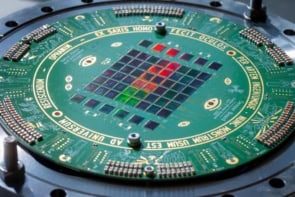The idea that fundamental constants do not actually stay constant over space and time has long played on the mind of physicists. But by looking at how a distant galaxy has absorbed the light from a quasar, researchers in Australia have obtained a new limit on how much one fundamental constant -- the ratio of the electron and proton masses -- is changing with time. Their result, which is 10 times more accurate than previous measurements, gives the thumbs up to our current understanding of physics (Phys. Rev. Lett. 98 240801).

constant?
Fundamental constants are very finely tuned for our existence – if the strong force were just 1% stronger than it is today, for example, carbon could not be produced in stars, and we would not be here at all. This is one reason why many physicists are eager to check whether certain fundamental constants have changed over the history of the universe.
One such fundamental constant is the ratio of the electron and proton masses, µ. Traditionally this has been measured by analysing data from a ground-based telescope that is pointed at a quasar – a compact but very bright nucleus of a young galaxy which serves as a “beacon” in distant space. The spectrum of light from quasars covers a broad range of wavelengths, but some of these wavelengths can be absorbed by molecules in older galaxies as the light travels through the cosmos. These wavelengths, called absorption lines, correspond to the molecules “jumping” to higher rotational or vibrational energy levels, and are governed by µ.
Because light from quasars can take billions of years to arrive at Earth, the value of µ measured from these distant sources can be compared with the value of µ measured in a lab experiment to see if the constant has changed over time. But now Victor Flambaum and Michael Kozlov of the University of New South Wales in Australia have made the technique more accurate by incorporating an analysis of an “inversion spectrum”, which is produced when atoms in molecules absorb light and quantum-mechanically tunnel to a higher energy level. Because the probability of tunnelling is more dependent on µ than the absorption lines in the rotation spectrum, it enables any time variations in µ to be calculated more accurately.
Flambaum and Kozlov took existing data from the Effelsberg radio telescope in Germany of light coming from a quasar through the galaxy B0218+357, 6.5 billion light-years from Earth, and examined both its inversion spectrum of ammonia molecules and its rotational absorption spectra of other molecules such as carbon monoxide. They then compared the spectra to those from present-day lab experiments. They found that µ cannot have decreased by more than 4 × 10-16 per year, and cannot have increased more than 2 × 10-16 per year – an estimate ten times more accurate than the previous best.
Last year, a group led by Wim Ubachs of VU University in Amsterdam, the Netherlands, found using the older technique that µ could be decreasing over time. If true, this would mean that the most fundamental theories in physics, such as Einstein’s theory of relativity, would have to be reconsidered. Flambaum told Physics Web, however, that his more accurate results show that µ is unlikely to have changed, so our current understanding of physics is safe. Moreover, he added that if more data is collated his analysis technique should enable theorists to determine variations in µ even more accurately.



